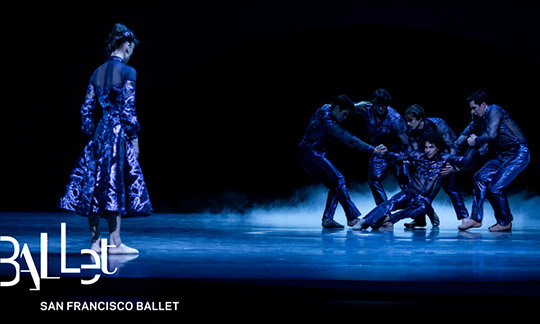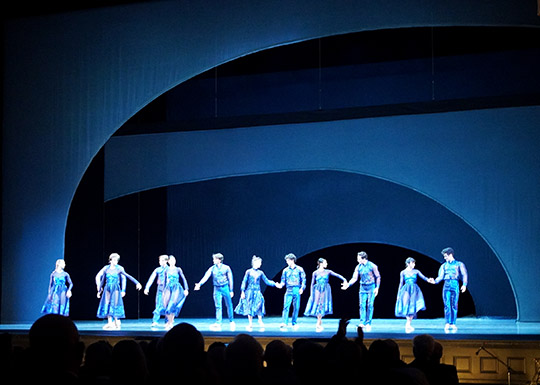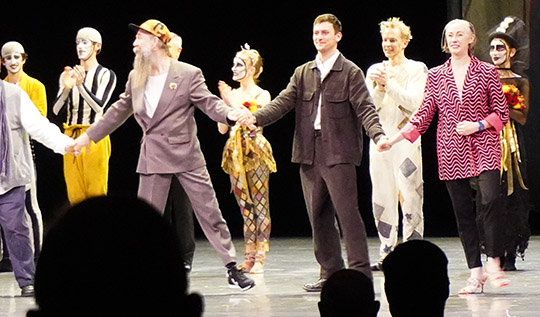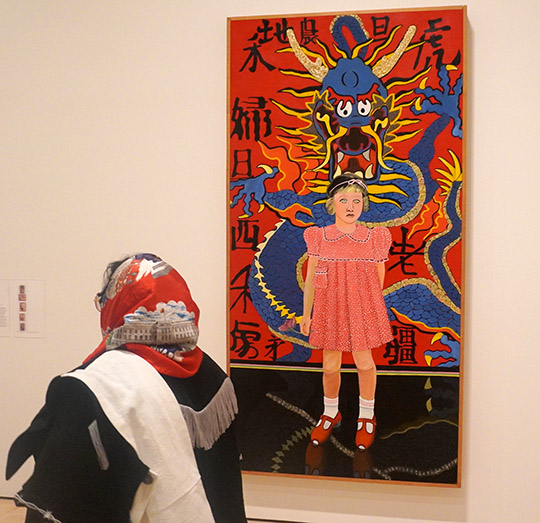The New Century Chamber Orchestra, under Music Director Daniel Hope, swept through the Bay Area last week with a program called Cinematic Escapes, featuring music by Bernard Herrmann, Tan Dun, Ennio Morricone, and George Gershwin.
I like all those composers, but unfortunately the reductions for string orchestra by British composer/conductor/arranger Paul Bateman just made me want to listen to the lush original versions of Bernard Herrmann's Vertigo Suite and a trio of Morricone themes from The Mission, Cinema Paradiso, and The Good, The Bad, and The Ugly.
One of the amusing highlights of the concert was watching all the cellists bouncing their heads in unison to the beat of Morricone's Spaghetti Western score, helped along by Artie Storch and Galen Lemmon, two percussionists positioned behind the strings,
A large percussion section was there for Tan Dun's Double Concerto for Violin, Piano and Strings (With Percussion), a work written expressly for the New Century Chamber Orchestra. It's a three-movement piece culled from his soundtracks for Crouching Tiger, Hidden Dragon and Hero and The Banquet. It's a brilliant work and a good example of repurposing movie music for sophisticated concert purposes.
Violinist Daniel Hope was joined in the concert by the Ukranian pianist Alexey Botvinov, one of the major figures of Odessa's musical life who was touring with Hope when Russia invaded his country. Hope and Botvinov have recorded music by Schnittke and Silvestrov for Deutsche Grammophon along with a charity project, Music for Ukraine, a collection of classical music from that embattled country. It was a delight to hear him.
Thursday, January 26, 2023
Monday, January 23, 2023
SF Ballet's next@90 Program 1
The San Francisco Ballet is celebrating its 90th anniversary with a new Artistic Director, Tamara Rojo, and a festival called next@90 featuring nine commissioned world premiere ballets.
Friday night's festival opening began with Haffner Serenade, choreographed by Dance Theater of Harlem veteran Robert Garland. This season was programmed by outgoing director Helgi Tomasson, and Haffner Serenade looked a bit like one of his lesser works, neo-classical in the Balanchine style and duller than the lively Mozart music that accompanied it.
Thankfully, the dancers and the orchestra were both delightful, and principal dancer Esteban Hernández was in a class of his own as he smoothly glided through solos and duets with Julia Rowe. (All production photos with a logo are by Lindsay Thomas.)
The second work on the program, Resurrection, choreographed by Alvin Ailey Dance Theater veteran Jamar Roberts, was extraordinary. The dancing worked so seamlessly with the long first movement of Mahler's Second Symphony that it felt like the music had been written expressly for the ballet. It also heralded the return to the company of Esteban's brother Isaac Hernández, who decamped to Europe in 2014. On the Continent he performed with the Nederlands Dans Theater before moving on to the English National Ballet, where he met and married Tamara Rojo, who is the new Artistic Director of the San Francisco Ballet. One of the pleasures of the upcoming season will be seeing plenty of The Fabulous Hernández Hermanos.
The energetic, modern dance inflected choreography was performed with virtuosic conviction by the whole ensemble, and there was an ambiguous narrative that involved a red parka vest and lots of stage fog. Not having read the program beforehand, I thought it was a gender-switched version of the Orpheus and Eurydice tale, where a woman brings back her lover from the land of the dead with tragic consequences. Choroeographer Roberts, however, writes what he was thinking: "An austere and malicious Queen uses her powers of persuasion, beauty, and magic in her quest to find a suitor to love and assist her in the rulership of her tribe." Dores André was wildly imperious as the Queen and Isaac Hernández as a zombie come to life was spectacular.
The final ballet of the evening was MADCAP from New Zealand choreographer Danielle Rowe (above right in the red jacket), and it was the audience hit of the evening. Set in a creepy circus, it was a riff on the old clown crying-on-the-inside while laughing-on-the-outside tale, danced by Tiit Helimets, a star who is retiring from the company this year. The ballet was set to songs by Pär Hagström (the bearded gent above), a Swedish pop music and theater composer, whose contribution sounded a bit like Nino Rota by way of Danny Elfman at a Cirque du Soleil show. The dancers were even called upon to sing, led by an amusing Jennifer Stahl as "The Oracle."
I thought the ballet a bit of an incoherent mess, but that's a minority opinion. My favorite moments were Parker Garrison (above) as a sweet, beautifully danced aspiring clown, along with the duo of Davide Occhipinti and Henry Sidford performing a sinuous duet with a red nose somehow suspended between their faces.
There are a half dozen more performances of this program at the SF Opera House over the next month in repertory with two other programs, and the whole festival looks fun and promising. (Click here for tickets.)
Friday night's festival opening began with Haffner Serenade, choreographed by Dance Theater of Harlem veteran Robert Garland. This season was programmed by outgoing director Helgi Tomasson, and Haffner Serenade looked a bit like one of his lesser works, neo-classical in the Balanchine style and duller than the lively Mozart music that accompanied it.
Thankfully, the dancers and the orchestra were both delightful, and principal dancer Esteban Hernández was in a class of his own as he smoothly glided through solos and duets with Julia Rowe. (All production photos with a logo are by Lindsay Thomas.)
The second work on the program, Resurrection, choreographed by Alvin Ailey Dance Theater veteran Jamar Roberts, was extraordinary. The dancing worked so seamlessly with the long first movement of Mahler's Second Symphony that it felt like the music had been written expressly for the ballet. It also heralded the return to the company of Esteban's brother Isaac Hernández, who decamped to Europe in 2014. On the Continent he performed with the Nederlands Dans Theater before moving on to the English National Ballet, where he met and married Tamara Rojo, who is the new Artistic Director of the San Francisco Ballet. One of the pleasures of the upcoming season will be seeing plenty of The Fabulous Hernández Hermanos.
The energetic, modern dance inflected choreography was performed with virtuosic conviction by the whole ensemble, and there was an ambiguous narrative that involved a red parka vest and lots of stage fog. Not having read the program beforehand, I thought it was a gender-switched version of the Orpheus and Eurydice tale, where a woman brings back her lover from the land of the dead with tragic consequences. Choroeographer Roberts, however, writes what he was thinking: "An austere and malicious Queen uses her powers of persuasion, beauty, and magic in her quest to find a suitor to love and assist her in the rulership of her tribe." Dores André was wildly imperious as the Queen and Isaac Hernández as a zombie come to life was spectacular.
The final ballet of the evening was MADCAP from New Zealand choreographer Danielle Rowe (above right in the red jacket), and it was the audience hit of the evening. Set in a creepy circus, it was a riff on the old clown crying-on-the-inside while laughing-on-the-outside tale, danced by Tiit Helimets, a star who is retiring from the company this year. The ballet was set to songs by Pär Hagström (the bearded gent above), a Swedish pop music and theater composer, whose contribution sounded a bit like Nino Rota by way of Danny Elfman at a Cirque du Soleil show. The dancers were even called upon to sing, led by an amusing Jennifer Stahl as "The Oracle."
I thought the ballet a bit of an incoherent mess, but that's a minority opinion. My favorite moments were Parker Garrison (above) as a sweet, beautifully danced aspiring clown, along with the duo of Davide Occhipinti and Henry Sidford performing a sinuous duet with a red nose somehow suspended between their faces.
There are a half dozen more performances of this program at the SF Opera House over the next month in repertory with two other programs, and the whole festival looks fun and promising. (Click here for tickets.)
Monday, January 16, 2023
Prokofiev and Tchaikovsky at the SF Symphony
After a month of seemingly endless Christmas concerts and acting as a soundtrack orchestra for movie showings of Jurassic Park and Home Alone, the San Francisco Symphony returned to its regular programming last weekend for an appreciative audience. It was a joy.
On Saturday evening, Davies Hall was almost completely full, possibly because local music critic Joshua Kosman had given the concert a rave review after its Thursday afternoon premiere.
I even noticed a gaggle of guys in a second tier box socializing, and thought it a brilliant idea. The acoustics and sightlines are surprisingly good up there, and the seats only cost $35.
The concert began with Moondog, a commissioned world premiere by composer Elizabeth Ogonek, above, that was a short, pleasant and evanescent evocation of the silvery orb creating mirror images from ice crystals (Ogonek was born in Minnesota).
This was followed by one of my favorite works by Sergei Prokoviev, his 1935 Violin Concerto No. 2. This piece contains all of Prokofiev's best qualities packed into 25 minutes: fabulous rhythmic propulsion, sincere lyricism, and a sarcastic, demonic wit all juggled together. The Canadian virtuoso James Ehnes gave a note-perfect performance along with two encores by Paganini and J.S. Bach for a rapturous audience.
The 37-year-old guest conductor, Elim Chan, did a fine job throughout, completing the program with a loud, hard-driving rendition of Tchaikovsky's 1872 Symphony No. 2. After the sophisticated Prokofiev, Tchaikovsky's symphony sounded sort of square and schlocky, but Chan and the orchestra gave such a heartfelt, committed performance that it did not matter. The final movement seemed to end with a catchy march tune at least a half dozen times before the finale, enough to create an earworm for the rest of the long weekend.
On Saturday evening, Davies Hall was almost completely full, possibly because local music critic Joshua Kosman had given the concert a rave review after its Thursday afternoon premiere.
I even noticed a gaggle of guys in a second tier box socializing, and thought it a brilliant idea. The acoustics and sightlines are surprisingly good up there, and the seats only cost $35.
The concert began with Moondog, a commissioned world premiere by composer Elizabeth Ogonek, above, that was a short, pleasant and evanescent evocation of the silvery orb creating mirror images from ice crystals (Ogonek was born in Minnesota).
This was followed by one of my favorite works by Sergei Prokoviev, his 1935 Violin Concerto No. 2. This piece contains all of Prokofiev's best qualities packed into 25 minutes: fabulous rhythmic propulsion, sincere lyricism, and a sarcastic, demonic wit all juggled together. The Canadian virtuoso James Ehnes gave a note-perfect performance along with two encores by Paganini and J.S. Bach for a rapturous audience.
The 37-year-old guest conductor, Elim Chan, did a fine job throughout, completing the program with a loud, hard-driving rendition of Tchaikovsky's 1872 Symphony No. 2. After the sophisticated Prokofiev, Tchaikovsky's symphony sounded sort of square and schlocky, but Chan and the orchestra gave such a heartfelt, committed performance that it did not matter. The final movement seemed to end with a catchy march tune at least a half dozen times before the finale, enough to create an earworm for the rest of the long weekend.
Wednesday, January 11, 2023
Joan Brown Retrospective at SFMOMA
A revelatory retrospective of the mostly unknown San Francisco artist Joan Brown (1938-1990) is gracing SFMOMA's top floor through early March.
Joan Brown was raised in a Catholic household in San Francisco's Marina District by an alcoholic father and a suicidal mother. In a wonderful 2011 online article by John Seed, he wrote: "Seventeen year old Joan's life pivoted when she noticed an advertisement for the California School of Fine Arts, which she decided to attend instead of the Catholic college her parents had in mind. Entering in 1955, she fell in love with the beatnik atmosphere of the school: bongo drums playing in the halls, guys with long hair, beards and sandals. Bright and charismatic, she immediately attracted male attention. "I have this extraordinary student," Elmer Bischoff told his colleague Wally Hedrick, "She's either a genius or very simple." (Pictured is Girl Standing (Girl with Red Nose, 1962.)
Her work was a precocious success that included a group show at the Whitney Museum and gallery representation in New York thanks to championing by her mentor Elmer Bischoff and painter David Park. (Pictured is Green Bowl, 1964.)
She married her first husband during art school, had it annulled like a good Catholic girl, then married sculptor Manuel Nuri with whom she had a son, Noel. The exhibit has a number of delightful expressionist style portraits of him growing up such as the 1964 Noel in the Kitchen.
Joan married her third husband, artist Gordon Cook, in 1968 and commemorated the event with the 1969 Joan + Rufus in front of S.F. Opera House. She decided to put aside her impasto expressionist style and in 1965 only worked on pieces in black-and-white. Color returned in 1968 along with a new, flat, cartoonish style that is uniquely her own.
Brown painted as many self-portraits as Frida Kahlo, another eccentric visionary whose work was ignored for decades until it became a full-blown cult. (Pictured is The Bride, 1970.)
She painted herself as a child in Chinatown...(Pictured is Portrait of a Girl, 1971.)
...as an adult with a cat face...(Pictured is Woman Wearing Mask, 1972.)
...and a admirer of Asian Art. (Pictured is The Room, Part 1, 1975.)
From all accounts, Brown was an intensely physical woman and was a serious San Francisco Bay swimmer. (Pictured is The Bicentennial Champion, 1976.)
In a dangerous Swim from Alcatraz in 1975, a large freighter came by and its wake nearly drowned two dozen swimmers, including Joan, who had to be rescued. (Pictured is After the Alcatraz Swim #3, 1976.)
Her series of paintings about the traumatic event are an exquisite mixture of calm and dark terror peering through the window. (Pictured is a detail from After the Alcatraz Swim #1, 1975.)
Brown was also a ballroom dancer...(Pictured is Dancers in a City #2, 1972.)
...whose depictions are so seductive that young people are taking selfies in front of them. (Pictured is Dancers in a City #4, 1973.)
Brown's fourth husband, Michael S. Hebel, was a San Francisco Police Department lieutenant who was interested in Eastern mysticism. The couple traveled to India in 1980 and she connected with the yogic guru Sai Sathya Baba (1926-2011), a rather dubious character who controlled a small spiritual empire with ashrams around the globe. Brown became a devotee and her painting style changed once again. (Pictured is Portrait of Mike, 1980.)
In the 1980s she began focusing on public art projects, often with tall, painted obelisks. It was during an installation at the guru's hometown village temple in Puttaparthi that a floor caved in above her and killed Joan and her two California assistants. She was 52 years old. (Pictured is Sacred Rocks on Nanda Devi, 1979.)
The three great art exhibits I have seen in San Francisco over the last year were all by 20th century American women who I had never heard of before: Alice Neel (click here), Faith Ringgold (click here), and now Joan Brown. It makes one wonder how many other neglected, modern women artists are still waiting to be discovered. (Pictured above is Harmony, 1982 and Self-Portrait in Studio, 1984.)
Joan Brown was raised in a Catholic household in San Francisco's Marina District by an alcoholic father and a suicidal mother. In a wonderful 2011 online article by John Seed, he wrote: "Seventeen year old Joan's life pivoted when she noticed an advertisement for the California School of Fine Arts, which she decided to attend instead of the Catholic college her parents had in mind. Entering in 1955, she fell in love with the beatnik atmosphere of the school: bongo drums playing in the halls, guys with long hair, beards and sandals. Bright and charismatic, she immediately attracted male attention. "I have this extraordinary student," Elmer Bischoff told his colleague Wally Hedrick, "She's either a genius or very simple." (Pictured is Girl Standing (Girl with Red Nose, 1962.)
Her work was a precocious success that included a group show at the Whitney Museum and gallery representation in New York thanks to championing by her mentor Elmer Bischoff and painter David Park. (Pictured is Green Bowl, 1964.)
She married her first husband during art school, had it annulled like a good Catholic girl, then married sculptor Manuel Nuri with whom she had a son, Noel. The exhibit has a number of delightful expressionist style portraits of him growing up such as the 1964 Noel in the Kitchen.
Joan married her third husband, artist Gordon Cook, in 1968 and commemorated the event with the 1969 Joan + Rufus in front of S.F. Opera House. She decided to put aside her impasto expressionist style and in 1965 only worked on pieces in black-and-white. Color returned in 1968 along with a new, flat, cartoonish style that is uniquely her own.
Brown painted as many self-portraits as Frida Kahlo, another eccentric visionary whose work was ignored for decades until it became a full-blown cult. (Pictured is The Bride, 1970.)
She painted herself as a child in Chinatown...(Pictured is Portrait of a Girl, 1971.)
...as an adult with a cat face...(Pictured is Woman Wearing Mask, 1972.)
...and a admirer of Asian Art. (Pictured is The Room, Part 1, 1975.)
From all accounts, Brown was an intensely physical woman and was a serious San Francisco Bay swimmer. (Pictured is The Bicentennial Champion, 1976.)
In a dangerous Swim from Alcatraz in 1975, a large freighter came by and its wake nearly drowned two dozen swimmers, including Joan, who had to be rescued. (Pictured is After the Alcatraz Swim #3, 1976.)
Her series of paintings about the traumatic event are an exquisite mixture of calm and dark terror peering through the window. (Pictured is a detail from After the Alcatraz Swim #1, 1975.)
Brown was also a ballroom dancer...(Pictured is Dancers in a City #2, 1972.)
...whose depictions are so seductive that young people are taking selfies in front of them. (Pictured is Dancers in a City #4, 1973.)
Brown's fourth husband, Michael S. Hebel, was a San Francisco Police Department lieutenant who was interested in Eastern mysticism. The couple traveled to India in 1980 and she connected with the yogic guru Sai Sathya Baba (1926-2011), a rather dubious character who controlled a small spiritual empire with ashrams around the globe. Brown became a devotee and her painting style changed once again. (Pictured is Portrait of Mike, 1980.)
In the 1980s she began focusing on public art projects, often with tall, painted obelisks. It was during an installation at the guru's hometown village temple in Puttaparthi that a floor caved in above her and killed Joan and her two California assistants. She was 52 years old. (Pictured is Sacred Rocks on Nanda Devi, 1979.)
The three great art exhibits I have seen in San Francisco over the last year were all by 20th century American women who I had never heard of before: Alice Neel (click here), Faith Ringgold (click here), and now Joan Brown. It makes one wonder how many other neglected, modern women artists are still waiting to be discovered. (Pictured above is Harmony, 1982 and Self-Portrait in Studio, 1984.)
Sunday, January 01, 2023
Rainy Renewal
The recent rains have been a godsend for my sister Sue's front yard in the Central California town of Arroyo Grande.
Her husband tore out their lawn in 2015 and replaced it with drought-resistant plants in 2015. The photo above shows what it looked like two years later.
It was a wise decision, as the plants managed to survive the recent drought years...
...and with the current rains targeting the Central California coast...
...the place is set to turn into a jungle of flowers...
...and succulents.
Between drought, pandemics, and the rise of global authoritarianism over the last seven years...
...the future has not been looking very promising.
Recently there has been a feeling of a sea change, a shift in consciousness, and for the first time in years I am feeling optimistic.
Happy New Year and let your drought-resistant garden grow.
Her husband tore out their lawn in 2015 and replaced it with drought-resistant plants in 2015. The photo above shows what it looked like two years later.
It was a wise decision, as the plants managed to survive the recent drought years...
...and with the current rains targeting the Central California coast...
...the place is set to turn into a jungle of flowers...
...and succulents.
Between drought, pandemics, and the rise of global authoritarianism over the last seven years...
...the future has not been looking very promising.
Recently there has been a feeling of a sea change, a shift in consciousness, and for the first time in years I am feeling optimistic.
Happy New Year and let your drought-resistant garden grow.
Subscribe to:
Comments (Atom)














































